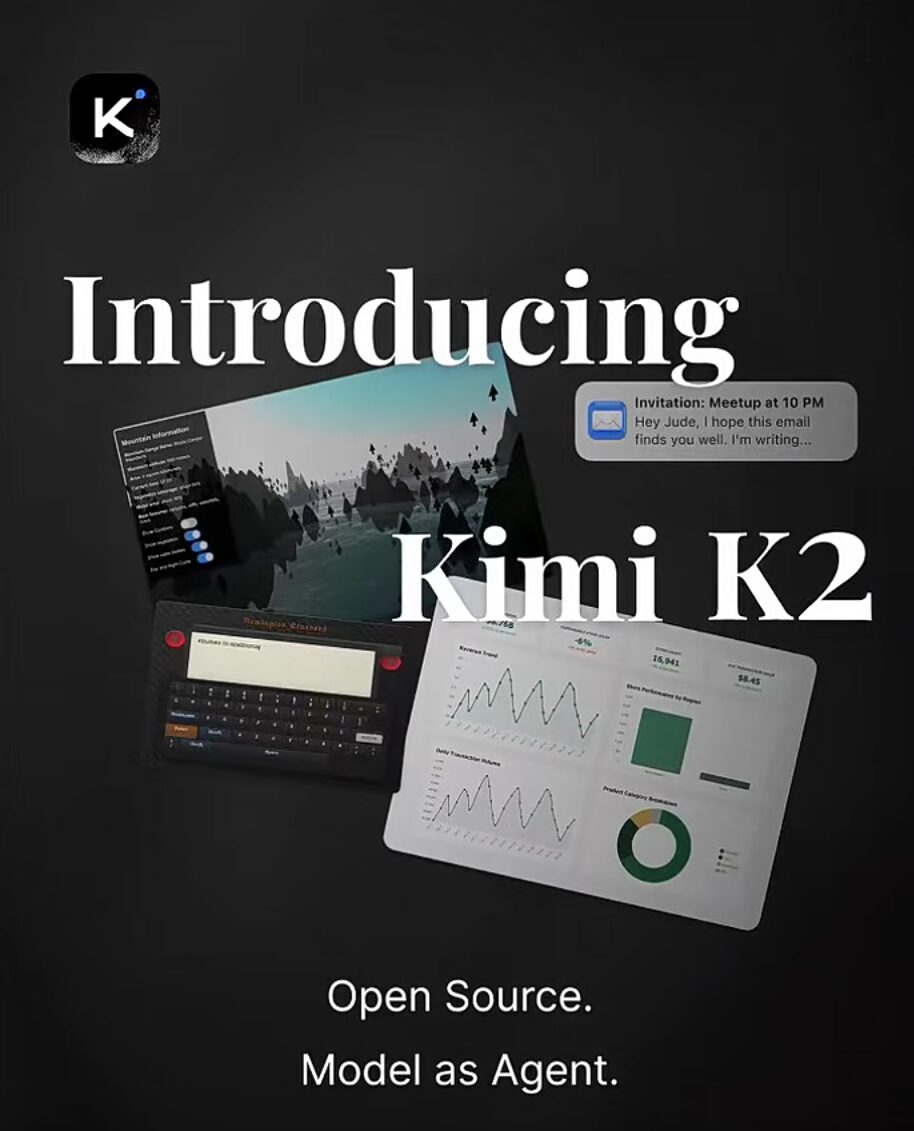Table of Contents
Overview
Step into the future of AI with Kimi K2 by Moonshot AI, a groundbreaking new open-source MoE model that’s setting new benchmarks in performance and efficiency. Released on July 11, 2025, this model boasts an impressive 1 trillion total parameters with 32 billion active at any given time, engineered to deliver state-of-the-art results across critical domains like coding, complex reasoning, and advanced agentic tasks. Both base and instruct versions are readily available, opening up new possibilities for developers and researchers alike.
Key Features
Delving deeper into what makes Kimi K2 a standout, here are its core capabilities:
- Trillion-parameter MoE model with 32B active parameters: Experience the power of a massive model while benefiting from efficient computation.
- Open-source with base and instruct variants: Access to both foundational and instruction-tuned models fosters transparency, research, and broad adoption.
- Optimized for coding, reasoning, and agentic tasks: Specifically designed to excel in areas requiring high precision, logical deduction, and autonomous action.
- State-of-the-art benchmark performance: Consistently achieves top-tier results on various industry benchmarks, proving its superior capabilities.
- Efficient computation through expert routing: Leverages an innovative architecture to maintain speed and reduce computational overhead despite its vast size.
- Advanced MuonClip optimizer: Utilizes breakthrough training stability technology enabling zero-failure training across 15.5 trillion tokens.
- Extended context window: Supports 128K token context length for processing large documents and complex reasoning tasks.
How It Works
Kimi K2’s impressive efficiency and performance stem from its sophisticated Mixture-of-Experts (MoE) architecture. Unlike traditional dense models where all parameters are engaged in every computation, Kimi K2 intelligently activates only a subset of its parameters, known as “experts,” during each inference pass. The model employs 384 experts with 8 selected per token, plus one shared expert for global context. This selective activation makes it remarkably computationally efficient. The magic lies in its “expert routing” mechanism, which dynamically selects precisely which sub-networks are utilized based on the specific input tokens. This ingenious design allows the model to scale to a massive parameter count while simultaneously maintaining fast performance, offering the best of both worlds.
Use Cases
Given its advanced capabilities and unique architecture, Kimi K2 is poised to revolutionize several key application areas:
- Code generation and debugging: Accelerate software development by generating high-quality code snippets and identifying/fixing bugs with high accuracy.
- Autonomous AI agents: Power sophisticated AI agents capable of complex decision-making, planning, and execution in dynamic environments.
- Complex reasoning and planning tasks: Tackle intricate problems requiring multi-step logical deduction and strategic foresight.
- Research into scalable model architectures: Serve as a foundational tool for academics and researchers exploring the next generation of highly efficient and powerful AI models.
- Enterprise agentic workflows: Enable businesses to automate complex multi-step processes with tool integration and API connectivity.
Pros \& Cons
Every cutting-edge technology comes with its unique set of advantages and considerations. Kimi K2 is no exception.
Advantages
- High efficiency despite massive parameter size, thanks to its MoE architecture and MuonClip optimizer technology.
- Open-source access fosters widespread research, innovation, and community development.
- Competitively strong performance across multiple language and reasoning benchmarks, including 65.8% on SWE-bench Verified.
- Cost-effective pricing at \$0.60 per million input tokens and \$2.50 per million output tokens.
- Exceptional agentic capabilities with specialized training for tool use and autonomous task execution.
Disadvantages
- Requires substantial compute resources for training and potentially for large-scale inference deployments.
- As a relatively new offering, its ecosystem and tooling are still evolving, which might require some early adopter effort.
- Local deployment requires high-end hardware making it less accessible for individual developers.
How Does It Compare?
When placed alongside its contemporaries in 2025, Kimi K2 carves out a distinct and compelling position in the competitive landscape.
Compared to DeepSeek R1, which leads in reasoning tasks, Kimi K2 demonstrates superior agentic capabilities and coding performance with its 65.8% SWE-bench Verified score.
Against Qwen3-235B, Kimi K2 offers better tool use and autonomous task execution while maintaining competitive reasoning performance.
While Claude 4 Opus provides excellent safety and reasoning capabilities, Kimi K2 stands out by being open-source and more cost-effective.
Compared to GPT-4.1, Kimi K2 achieves better coding performance (53.7% vs 44.7% on LiveCodeBench) and mathematical reasoning (97.4% vs 92.4% on MATH-500) while offering transparent, open-source access.
Furthermore, against Gemini 2.5 Pro, Kimi K2 provides comparable performance in most benchmarks but with the significant advantage of open-source availability and lower operational costs.
Final Thoughts
Kimi K2 by Moonshot AI represents a significant leap forward in the realm of open-source AI, offering an unparalleled combination of scale, efficiency, and performance. Its MoE architecture, advanced MuonClip optimizer, and focus on critical tasks like coding and agentic reasoning position it as a powerful tool for innovation. The model’s competitive performance against proprietary alternatives, combined with its open-source nature and cost-effective pricing, makes it an attractive choice for developers, researchers, and enterprises looking to implement advanced AI capabilities. While it demands considerable computational power and its ecosystem continues to mature, Kimi K2’s state-of-the-art capabilities and accessibility make it an incredibly promising development for advancing the boundaries of artificial intelligence.
